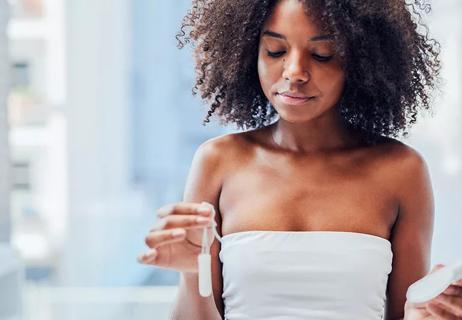Key steps include picking the right level of absorbency and inserting it at the correct angle

Whether you learned about tampons from your mom, an older sibling, your best friend or the side of a box, you may still have questions — even if you’ve been using them for years. And if you haven’t yet tried tampons because you’re just not sure how to use them, help has arrived.
Advertisement
Cleveland Clinic is a non-profit academic medical center. Advertising on our site helps support our mission. We do not endorse non-Cleveland Clinic products or services. Policy
“There is a little sense of embarrassment in talking about your period,” says women’s health specialist Sara Youngblood, CNP. “If you don’t have anyone in your family who is open to having that discussion, it becomes even more of a barrier to getting the proper knowledge on how to use tampons.”
Youngblood walks you through the steps to insert a tampon properly while also answering some of your most pressing questions.
Putting a tampon in wrong can cause discomfort and leakage. When you put it in right, though, it’s able to do its job — absorb menstrual blood and allow you to live your life worry-free while you’re on your period.
“Tampons are a great option for most people because they’re discreet and easy to use,” Youngblood says.
Before inserting a tampon, let’s go over all of its parts and define what they mean. The first thing to know is that the word “tampon” is actually used two ways:
This can make things a little confusing, so let’s identify all of the components:
Advertisement
Not all tampons have applicators. But if this is your first time using a tampon, it’s best to use one that does, as they’re a little bit easier to insert. “And plastic applicators are more comfortable to insert than cardboard ones,” Youngblood advises.
Here’s a step-by-step look at inserting a tampon correctly, including some essential things to know along the way.
Tampons are categorized by how absorbent they are, meaning how much blood they’re able to soak up. “They’re not gauged on the size of your vagina,” Youngblood explains. “The words used to describe them actually relate to how heavy your period is.”
So, terms like “junior” or “light” tampons are for lighter blood flows, while “super” or “ultra” are for heavy period days. And you might need to use different absorbency levels for different days of your period. (Unfortunately, there’s no way to tell how heavy your flow will be. But over time, you may start to notice patterns about your period, including when it’s likely to be heaviest and lightest.)
Here’s a breakdown:
“If you notice that your tampon is heavily saturated with blood within a short period of time, you may need to go up in absorbency,” Youngblood says. “And vice versa: If your period isn’t very heavy and you see empty, white, unsaturated areas on the tampon when you take it out, consider going down in absorbency.”
Before you insert a tampon, visit the sink — and be sure to use soap. “You’re putting something into your vagina, so you want to try to keep everything as clean as possible, which will prevent bacteria from getting inside your vagina as well,” Youngblood says.
If you’re not familiar with using tampons, inserting one might make you nervous. But when you’re nervous, you tense up, which can actually make it harder for you to get the job done.
“When you’re tense and fearful, your vaginal muscles constrict, which can make inserting a tampon difficult or uncomfortable,” Youngblood explains.
Take a few calming breaths before you begin. As you inhale and exhale, allow your body to relax and your muscles to unclench. You’ve got this!
You can insert a tampon while sitting on the toilet. “Spread your legs wide and put your knees apart, just a little bit wider than your hips,” Youngblood instructs — sort of like you’re going to do squats.
Advertisement
If you’re new to the process and want a little more space, though, you can put one foot up on the toilet or the bathtub. This might help you to better insert the tampon at an angle (which we’ll talk about in step 6).
Unwrap your tampon and hold it with your dominant hand. Hold the bottom of the applicator with your thumb and your middle finger, while you use your pointer finger to cover the end of the plunger (where the string comes out).
This will give you the leverage you need to push the plunger up into the applicator, which is what pushes the tampon out of the applicator and into your body.
First, a quick anatomy lesson. What we tend to refer to as the vagina is actually the labia — those “lips” or folds of skin that make up the outer part of your genitals. The tampon itself goes into your vagina and up your vaginal canal, which is a tunnel inside of your body.
To get ready to insert a tampon, use your non-writing hand to spread your labia, which will give you access to the opening of your vagina.
“Holding the tampon with one hand and holding the labia apart with your other hand, place the tip of the applicator at the entrance of your vagina,” Youngblood says.
Slowly and gently insert the applicator into your vagina until the base of the applicator — where your thumb and middle fingers are holding it — reach the entrance of your vagina. The plunger should be still sticking out of your vagina.
Advertisement
Now, use your other index finger (the one that’s been on the end of the plunger) to push the plunger up inside the applicator. This will insert the absorbent core into your vagina. At this point, the plunger will be nested inside the applicator, and only the cotton string will be left hanging out of your vagina.
Though you may be inclined to point the tampon straight upward or to angle it toward your stomach, that will cause it to be in an uncomfortable position. “You want to point it toward your rectum or your back, which goes along the natural curve of the female reproductive system,” Youngblood says.
This is critical: The applicator doesn’t stay inside of your body! It’s just there to help you insert the absorbent core with ease. After the core is inside of you, it’s time to remove the applicator.
“After you’ve inserted the plunger, lightly pull out the plastic or cardboard barrel,” Youngblood says. “Leave the tampon in place, with just the string hanging outside of your body.”
Don’t pull on the string, though, which can loosen the tampon and cause discomfort.
Think of the tampon wrapper as a little trash bag for the applicator. “Most tampon packaging serves as a little pouch,” Youngblood says. “Place the applicator back into the pouch and dispose of it in the garbage.”
Advertisement
If you’re self-conscious about other people seeing it in the trash can, you can also wrap it in a piece of toilet paper. But remember: Menstruation is normal, and so is the use of menstrual products.
Just be sure not to put the applicator, wrapper or used cotton tampons into the toilet, which can lead to serious plumbing issues.
When it comes time to take out your tampon, just tug gently on the string to remove it from your vagina.
And although tampons are very safe to use, you should never leave the same tampon in for longer than eight hours. “Even if your tampon isn’t completely soaked through with blood, it’s important that you take it out in a timely fashion,” Youngblood stresses. “Otherwise, you risk health issues like toxic shock syndrome.”
Remember: The type of tampon you use should depend on how heavy your flow is. If you’re bleeding a lot and your tampon is soaked through in just a couple of hours, try a higher-absorbency tampon. But if it’s coming out of your vagina with lots of white spots still visible, switch to a lower-absorbency tampon or a sanitary pad instead.
“You might feel a little discomfort when you first put in a tampon, especially if your period isn’t heavy yet,” Youngblood states. “Your vaginal walls aren’t as lubricated as they are during a heavy period, which causes a little more friction in your vagina.”
Once a tampon is in position, though, it shouldn’t cause any pain or discomfort. “Tampons should definitely not hurt,” she says. “If it hurts after you’ve put it in, there could be a few things at play.”
Congrats, you’ve done it! Enjoy the next few hours without a period-related care in the world.
Learn more about our editorial process.
Advertisement

Nothing scented should go in or around your vagina!

It depends on your menstrual flow, and a little trial and error

Yes, with the right absorbency level and maximum time-frame

Homemade doesn't always mean safe

From using one at night to how often you should change them

Use them within five years and store them someplace cool and dry

They won’t make your cramps worse or stretch out your vagina!

In addition to toxic shock syndrome, you risk other vaginal infections

The best parenting style balances enforcing rules and showing plenty of love

Tips include cutting back on sugar, focusing on exercise and managing stress

It can be harder to let go when you’ve invested time, energy and emotions — but it might be the healthier choice long term